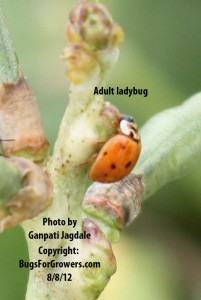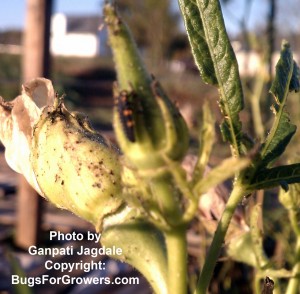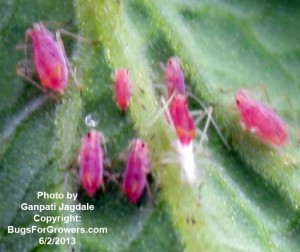Now is the right time to use ladybugs to control aphids, mealybugs, mites, scales and thrips- Bugsforgrowers.com
Click YouTube video below to learn about predatory ladybugs and how they control aphids and other insect pests.
Description: Ladybird beetles are also called as ladybugs and scientifically known as Hypodamia convergens. Both larvae and adults of ladybugs are active predators of many soft bodied insects including aphids, mealy bugs, mites and scale insects. Adult ladybugs are hemispherical shaped and bright orange to red in color with 6 black spots on each wing (Fig. 1) whereas larvae have appearance like an alligator with yellow stripes and reddish dark brown color (Fig. 2). Since adults of ladybugs are very active predators, they can move very fast after their release and find their prey in the garden. Each adult of ladybug is capable of eating over 5000 aphids whereas each larva in its life-span can eat over 400 aphids (Fig. 3). Use of ladybugs as biological control agents in the organic gardens is a good choice because released ladybug adults can continuously reproduce and maintain their populations as long as they find their food in the garden. For example, once ladybugs are released in the garden, they immediately start feeding on their prey. While feeding they mate and lay up to 1,500 tiny yellow eggs on foliage. Eggs hatch within a week into blackish brown alligator like larvae, which are very mobile. After hatching, these larvae immediately start feeding on the available insect hosts in the garden. While feeding, larvae molts 3 times before pupation. The pupae are orange to black in color and attached to any substrate in the garden. Young adults emerge from pupae within 1-2 weeks and life cycle continues. Ladybugs generally complete several generations in a year and they hibernate as adults during winter.



Ladybugs are effective against following insect pests
- Aphids
- Mealy bugs
- Mites
- Scale insects
- Thrips
How ladybugs are applied in the organic garden?
Ladybugs are commercially available and they sold about 1500 adults in a bag and one such bag is enough to treat about 900 square foot area of garden. After purchasing, if it is possible, release adults immediately at dusk in watered garden near plants infested with aphids or other host insect pests. If it is not possible to release ladybugs immediately after arrival, they can be stored in the refrigerator at 38o F (4oC) until you are ready to release them in the garden. However, for their highest survival rate in the refrigerator, it is recommended that the bags containing lady bird beetles should be pre-conditioned upon arrival by rinsing bags under cold water and then transfer them into the refrigerator at 4oC (38o F).
Are ladybugs safe to use as biological control agent?
Yes, as they are not harmful to humans, children and pets.
Research Papers:
